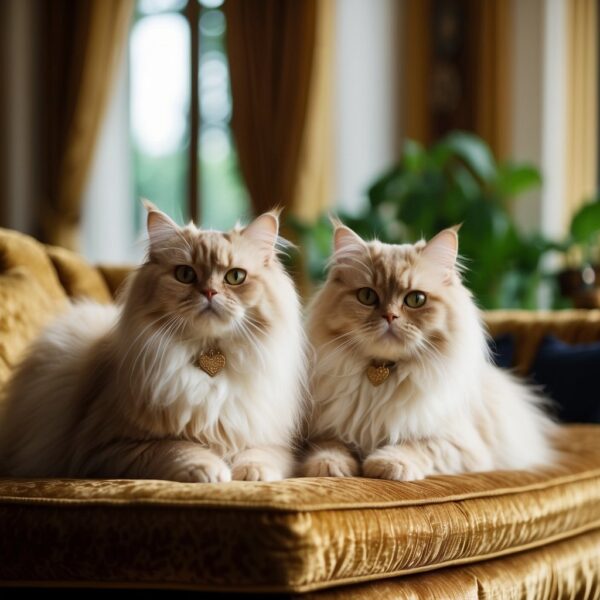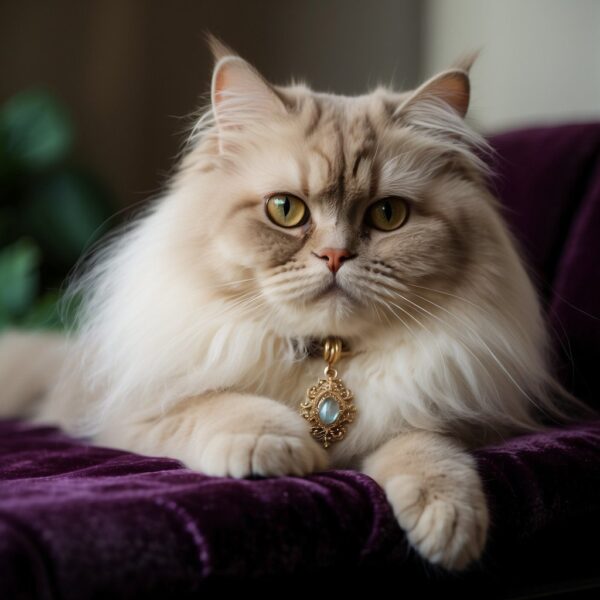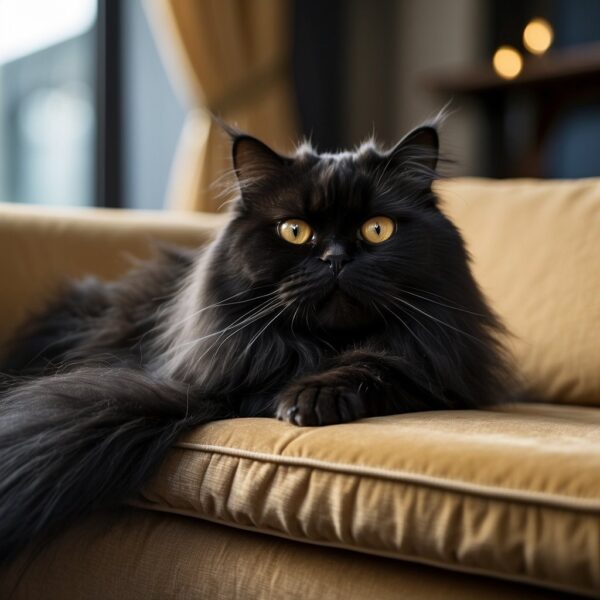
Iranian Cats: A Guide and Characteristics
Iranian cats, particularly Persian cats, boast a rich heritage steeped in history and cultural significance. Originating from the mountainous areas of Persia, now modern-day Iran, these felines have long been cherished for their striking appearance and amiable personalities. The Persian cat is notable for its luxurious long hair, gentle demeanor, and a distinctive face that features large, expressive eyes and a short muzzle.
Their elegant appearance has captivated the admiration of cat enthusiasts worldwide, making them one of the most recognized and sought-after breeds. However, the Persian cat is not only valued for its looks; it also possesses a calm and affectionate behavior, making it an ideal cat for those seeking a serene companion. The breed’s long history includes its spread to the West where breeders have selectively bred them to enhance specific desirable traits, further cementing their status in the world of feline aristocracy.
Key Takeaways
- Persian cats are an ancient breed from Iran, known for their distinct appearance and plush fur.
- These cats are characterized by their calm and loving temperament, making them popular pets.
- They require dedicated grooming and have a history that includes royal admiration and widespread allure.
Origins and History
Persian cats boast a storied lineage tracing back to ancient Persia, with notable historical figures contributing to their dispersion across continents. Their legacy extends from their early beginnings in Persia, through their introduction to Europe by an Italian traveler in the 1600s, to ultimately finding a place in the homes of American and European families.
Early Beginnings in Persia
The Persian cat’s ancestral roots lie deep within the cradle of civilization, in regions historically known as Persia and Mesopotamia, territories corresponding to modern-day Iran. These cats were likely bred from the region’s native long-haired species.
Pietro Della Valle’s Influence
Italian traveler Pietro Della Valle played a crucial role in the breed’s history by bringing the first long-haired cats to Europe from his travels in Persia during the 1600s. This significant event marked the formal introduction of the Persian breed to European admirers.
Spread to Europe and America
After their introduction to Europe, Persian cats quickly found favor among the nobility, including Queen Victoria of England, enhancing their status as a symbol of luxury and refinement. The breed’s popularity led to its spread across Europe and eventual introduction to America, where it became a cherished pet.

Iranian cats Physical Characteristics
In the realm of feline breeds, Iranian cats, notably Persian cats, are distinguished by their unique aesthetics, ranging from lush coats to their iconic facial structure.
Breed Description
Persian cats, originating from Iran, fall in the medium-to-large size category, with a robust and sturdy body structure. The breed typically exhibits short, muscular legs and a proportionate tail, complementing their overall physique. As an established breed, Persians have a well-defined standard that includes a short back and a deep chest, contributing to their powerful appearance.
Color Variations
The luxurious coat of a Persian cat is one of its most striking features, and it can come in an impressive array of colors and patterns. These range from solids to bi-colors, and exotic shades to classic patterns. Some of the recognized coat colors include, but are not limited to:
- White
- Black
- Blue
- Red
- Cream
- Silver
- Golden
Persians can also showcase coat patterns like tabby, calico, and shaded, each adding to their unique charm.
Distinctive Features
The defining charm of Persian cats lies in their distinctive flat face, also known as a “Peke-face”, characterized by a round face with full cheeks. They have large, round eyes that can exhibit an array of eye colors, enhancing their sweet expression. Their long fur, which necessitates regular grooming, adds to their regal demeanor, while their flat noses and medium-sized ears sit perfectly within their plush appearance. Despite their tranquil appearance, they carry a surprising amount of strength and agility.

iranian cats Health and Care
The well-being of Iranian Cats, like all breeds, hinges on understanding their specific health considerations and grooming needs. Addressing these points helps ensure a longer, more vibrant life for these animals.
Common Health Concerns
Iranian Cats, typically known as Persian cats, may be prone to several health issues that prospective and current owners should be aware of. Polycystic Kidney Disease (PKD), a genetic condition, and Hypertrophic Cardiomyopathy (HCM), a heart disease, are relatively common within the breed. Progressive Retinal Atrophy (PRA), which can lead to blindness, is another concern, as is Malocclusion, a misalignment of the teeth that can affect eating and oral health. It’s essential to provide regular veterinary check-ups to monitor for these conditions.
- Polycystic Kidney Disease (PKD)
- Hypertrophic Cardiomyopathy (HCM)
- Progressive Retinal Atrophy (PRA)
- Malocclusion
- Allergies
Grooming Requirements
Persian cats are known for their luxuriant, fluffy coats which require extensive grooming. Daily brushing helps to prevent matting and shedding and is crucial for maintaining their overall health. Bathing, typically recommended at least once a month, can help to keep the coat clean and reduce the buildup of oils. Persian cats typically don’t require rigorous exercise, but a consistent, moderate level will aid in preventing obesity and related health problems. Diet plays a critical role in their care; optimal nutrition is necessary to support their health and coat quality.
- Daily Brushing: Essential to prevent matting
- Bathing: Monthly or as needed to maintain coat cleanliness
- Exercise: Moderate, regular activity
- Nutrition: High-quality diet to support health and coat quality

iranian cats Behavior and Temperament
Persian cats are known for their gentle and affectionate nature, often becoming a beloved part of the family dynamic. They typically exhibit a demeanor that is calm and undemanding, making them ideally suited to indoor living and companionship.
Personality Traits
- Gentle: Persian cats are renowned for their gentle disposition. They are usually serene and placid, displaying a sense of dignity and grace in their movements.
- Sweet: A typical characteristic of these cats is their sweet-natured temperament, which endears them to their human companions.
- Affectionate: These felines are affectionate and often form strong bonds with their owners, seeking attention and cuddles.
- Quiet: Persians are not known for being particularly vocal. They communicate their needs and desires without making a lot of noise.
Interaction with Family and Pets
- Children: Persian cats can be good companions for children due to their patient nature, as long as the children treat them with the gentleness they require.
- Other Pets: They generally get along well with other pets, particularly if raised together from a young age. However, introductions should be done thoughtfully to ensure a smooth transition.
- Companion: As companions, Persian cats are friendly and tend to be quite adaptive to the home environment, fitting in seamlessly with the household’s daily rhythm.
- Intelligence: Their intelligence allows them to be responsive to the mood of the household, and they often seek out quiet when chaos reigns.
iranian cats Cultural Impact and Popularity
Iranian cats, especially Persian cats, have made a significant impact in various societies, highlighting their role in popular culture and their status among cat enthusiasts.
Famous Associations
Historically, Persian cats have been associated with royalty and nobility. These elegant felines garnered a prestigious reputation due to Queen Victoria’s admiration for them, which further cemented their popularity among the aristocracy. Their prominence was not just limited to realms of grandeur but extended into popular culture.
In Films and Shows
- Featured in numerous movies
- Appear in television programs
In Competitive Arenas
- Regular participants in international Cat Shows
- Recognized by major organizations such as the Cat Fanciers’ Association (CFA)
Current Status in Society
Today, Persian cats remain a popular choice for pet parents across the world. Their calm demeanor and luxurious appearance continue to attract a following, ensuring their place as a favorite among various Cat Breeds.
Among Cat Enthusiasts
- Desirable for their regal aura and long, silky coats
- Collectors and cat lovers prize them for their unique aesthetic
In Modern Households
- Adapt well to indoor living
- Maintained their reputation as a companion animal
Practical Considerations
Persian cats, often referred to as Iranian cats, have distinctive needs in terms of living conditions, life expectancy, and breeding practices. These factors are crucial for potential guardians to understand in order to provide these cats with a fulfilling and healthy life.
Living Conditions
Persian cats thrive in a serene and stable home environment. Their long, luxurious coats demand daily grooming to prevent matting and maintain cleanliness. Ideal living conditions include a climate-controlled space to avoid overheating, as Persian cats can be sensitive to extreme temperatures. Guardians should also be vigilant about eye care due to their facial structure, which can lead to accumulated discharge that requires regular cleaning.
Life Expectancy
The average lifespan of a Persian cat is typically between 12 to 17 years. However, various factors including genetics and overall health care can influence this. Persian cats are susceptible to certain hereditary conditions like Polycystic Kidney Disease (PKD), which can impact their longevity. Guardians need to ensure regular veterinary check-ups and adopt preventive health measures to enhance their Persian’s life expectancy.
iranian cats Breeding and Varieties
Persian cats are pedigreed, and selective breeding is commonplace to maintain certain aesthetic and physical traits. Breeders often focus on producing a variety of coat colors and patterns. Prospective parents should seek reputable breeders who test for common genetic conditions, such as PKD, to ensure they are adopting a healthy kitten. It’s important to understand that while selective breeding can preserve desirable traits, it can also perpetuate health issues if not done responsibly.

Frequently Asked Questions
Persian cats, also known as Iranian cats, have unique characteristics and a rich cultural symbolism. Their distinct personalities, lifespans, and facial structures are frequently discussed among enthusiasts.
What are some popular Iranian cats names?
Popular names for Persian cats often reflect their noble and plush appearance. Names such as Cyrus, Darius, and Shirin are common, drawing from the rich history of Persia. Additionally, names like Simin, meaning “silver,” or Behruz, denoting “good day,” are favored for their cultural significance.
How would one describe the personality traits of Iranian cats?
Persian cats are typically characterized by their calm and gentle demeanor. They are docile, enjoying peaceful environments, and often displaying affection towards their guardians. These cats may exhibit playful bursts of energy, but most of the time, they prefer lounging and interacting softly with their human companions.
What is the typical lifespan of a Persian cat?
The typical lifespan of a Persian cat ranges from 12 to 17 years. This can vary based on various factors, including genetics, diet, and overall quality of care. Regular veterinary check-ups and a nurturing home environment are essential for a long and healthy life.
What are the differences between the traditional and Peke-face Persian cat?
The traditional Persian, also known as the Doll-face Persian, has a more moderate facial structure with a visible nose. In contrast, the Peke-face Persian exhibits an extremely flat face with the nose set between the eyes. This brachycephalic feature is the result of specific breeding practices.
How can you identify the various types of Persian cat faces?
Persian cats can be identified by their facial structures, which range from the traditional Doll-face to the Ultra-face with an extremely flat profile. The Doll-face has a more pronounced muzzle, while the Peke-face and Ultra-face have shorter muzzles and more extreme facial flatness, leading to more pronounced facial folds.
What does the cat symbolize within Iranian culture?
In Iranian culture, cats are often revered and symbolize grace, beauty, and mystery. The Persian cat, in particular, is associated with luxury and nobility, reflecting the historic grandeur of Persia. Cats are often seen as protective entities, with mythological significance that dates back to ancient Persia.